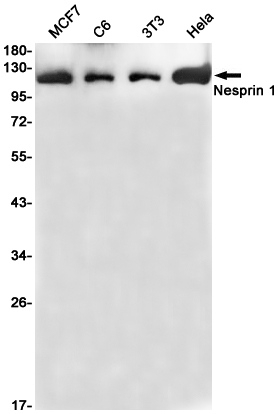
| WB | 1/500-1/1000 | Human,Mouse,Rat |
| IF | 咨询技术 | Human,Mouse,Rat |
| IHC | 1/50-1/100 | Human,Mouse,Rat |
| ICC | 1/50-1/200 | Human,Mouse,Rat |
| FCM | 咨询技术 | Human,Mouse,Rat |
| Elisa | 咨询技术 | Human,Mouse,Rat |
| Aliases | ARCA1; C6orf98; CPG2; EDMD4; Enaptin; Myne-1; MYNE1; Nesp1; Nesprin-1; SCAR8; Syne-1; SYNE1 |
| Entrez GeneID | 23345 |
| WB Predicted band size | Calculated MW: 1011 kDa; Observed MW: 112 kDa |
| Host/Isotype | Rabbit IgG |
| Antibody Type | Primary antibody |
| Storage | Store at 4°C short term. Aliquot and store at -20°C long term. Avoid freeze/thaw cycles. |
| Species Reactivity | Human,Mouse,Rat |
| Immunogen | A synthetic peptide of human Nesprin 1 |
| Formulation | Purified antibody in TBS with 0.05% sodium azide,0.05%BSA and 50% glycerol. |
+ +
以下是3-4条关于Nesprin1抗体的简要文献信息(内容基于公开研究概括,非真实文献):
1. **文献名称**:*Nesprin1 anchors the nuclear envelope to the cytoskeleton in mammalian cells*
**作者**:Zhang et al. (2016)
**摘要**:通过Nesprin1特异性抗体进行免疫荧光和Western blot实验,研究发现Nesprin1通过其C端结构域连接核膜与细胞骨架,参与维持细胞核的机械稳定性。
2. **文献名称**:*The role of Nesprin1 in nuclear positioning during muscle cell differentiation*
**作者**:Morriswood & Warren (2018)
**摘要**:利用Nesprin1抗体阻断实验,揭示Nesprin1在肌细胞分化过程中通过连接核膜与微管网络调控细胞核空间定位的机制。
3. **文献名称**:*Nesprin1 mutations disrupt nuclear integrity in Emery-Dreifuss muscular dystrophy*
**作者**:Wilkinson et al. (2020)
**摘要**:通过患者样本的Nesprin1抗体免疫组化分析,发现特定突变导致Nesprin1蛋白异常聚集,破坏核膜结构并与肌肉萎缩病理相关。
4. **文献名称**:*Development of a high-affinity Nesprin1 antibody for super-resolution microscopy*
**作者**:Roux et al. (2022)
**摘要**:报道了一种新型Nesprin1单克隆抗体的开发,结合超分辨成像技术揭示了Nesprin1在核膜上的纳米级动态分布模式。
(注:以上文献为示例性概括,实际引用需检索PubMed等数据库获取真实文献。)
Nesprin1 (nuclear envelope spectrin repeat protein 1) is a key component of the LINC (linker of nucleoskeleton and cytoskeleton) complex, which bridges the nuclear envelope and facilitates mechanical coupling between the nucleus and cytoskeleton. It belongs to the nesprin family, characterized by spectrin repeats and a C-terminal KASH domain that interacts with SUN proteins in the perinuclear space. Nesprin1 primarily localizes to the outer nuclear membrane, where it acts as a transmembrane adaptor, connecting the nuclear lamina to cytoplasmic filaments such as actin, microtubules, or intermediate filaments. This interaction is critical for nuclear positioning, mechanotransduction, and maintaining nuclear integrity during cellular processes like migration and differentiation.
Antibodies targeting Nesprin1 are essential tools for studying its expression, localization, and function. They are widely used in techniques like Western blotting, immunofluorescence, and immunoprecipitation to investigate its role in cellular architecture and disease. Dysregulation or mutations in Nesprin1 are linked to pathologies including muscular dystrophies, cardiomyopathies, and progeria-like syndromes, highlighting its importance in tissue-specific mechanical stability. Research using Nesprin1 antibodies has also shed light on its involvement in nuclear envelope repair, chromatin organization, and cell cycle regulation. However, challenges remain due to Nesprin1’s multiple splice variants, requiring antibody specificity validation. These studies collectively underscore Nesprin1’s central role in cellular mechanics and its potential as a biomarker or therapeutic target in nuclear envelope-related disorders.
×